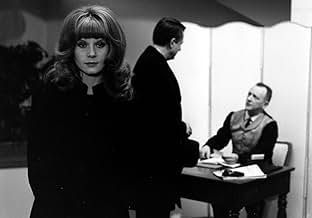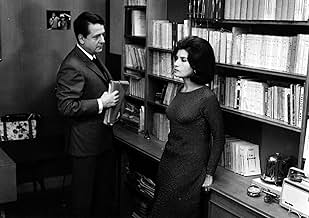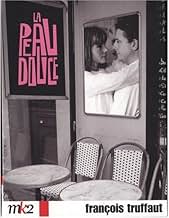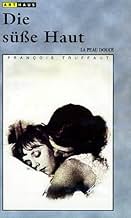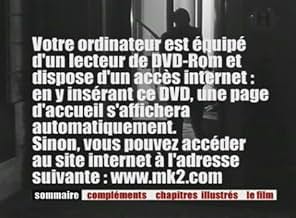IMDb रेटिंग
7.5/10
8.8 हज़ार
आपकी रेटिंग
अपनी भाषा में प्लॉट जोड़ेंA well-known publisher and lecturer starts an affair with an air hostess.A well-known publisher and lecturer starts an affair with an air hostess.A well-known publisher and lecturer starts an affair with an air hostess.
- निर्देशक
- लेखक
- स्टार
- पुरस्कार
- 1 जीत और कुल 2 नामांकन
Françoise Dorléac
- Nicole
- (as Françoise Dorleac)
Carnero
- Lisbon organizer
- (बिना क्रेडिट के)
Georges de Givray
- Le père de Nicole
- (बिना क्रेडिट के)
Catherine-Isabelle Duport
- Jeune fille Reims
- (बिना क्रेडिट के)
Maximiliènne Harlaut
- Mme. Leloix
- (बिना क्रेडिट के)
Charles Lavialle
- Veilleur hôtel Michelet
- (बिना क्रेडिट के)
फ़ीचर्ड समीक्षाएं
Imagine how director François Truffaut felt at the Cannes premiere of this film as more than half the audience walked out. In terms of audience approval, "La peau douce" was Truffaut's big disaster. Why did audiences hate it so much? For the exact reasons that it is a landmark film.
1. The main character is not very likeable; he's almost completely expressionless even though this is a love story. 2. Certain events happen in a way that isn't exactly realistic: an elevator takes nearly 2 minutes to travel up 5 floors but only 15 seconds on the way down. 3. Certain events happen without any dialogue or explanation, just a succession of close ups showing objects and activity. But these 3 points are very deliberate, and they are what make "La peau douce" such a tremendous work of art.
1. Why is the main character not likeable? As Truffaut said, this film is "an autopsy of adultery". The story is about a respectable man with a meticulously perfect life who engages in a very imperfect affair. Truffaut wanted to present everything as objectively as possible so that we can analyze all the elements without the prejudice of sentimentality. So he made the lead actor Jean Desailly play the role of "Lachenay" with neutrality; we sense deep emotion, but there are no melodramatic scenes of outward expression as we've come to expect in love stories. If you think about it, isn't that how most people's love lives are? We don't usually get dramatic closeups with soft lighting and complimentary filters. An objective observer woudn't necessarily sympathize with what we're feeling but rather would scrutinize our actions & choices. And as far as that goes. Lachenay makes some pretty bad ones.
2. How realistic is the storytelling? At times, not very. But this style is one of the greatest examples of "hyper realism" which is something Truffaut learned from his mentor and idol Alfred Hitchcock. For example in the elevator scene, time is stretched on the way up, intensifying the first meeting between Lachenay and Nicole (excellently played by Françoise Dorléac, the carefree, outgoing sister of Catherine Deneuve). Only a handful of words are said, but in true Hitchcockian form it's a very suspenseful and portentous scene that deserves its full 2 minutes. The same elevator ride down, with Lachenay alone, is designed to give us contrast and return us to the realistic world as the 5-floor descent is shown in real time, only 15 seconds.
3. Dude where's the dialogue? It's there, but sometimes it's conspicuously absent like in the entire seduction scene which consists of a wordless walk down a hotel hallway, a fumbling for some keys, a lingering stare, hands touching as a door is opened, one hand turning on the light while another hand turns it off, and finally a magnificent dark silhouette of 2 people facing each other. Fade to black. Did we really need any dialogue to understand exactly what was going on in their heads? No, we didn't even need any facial expressions. Again drawing an idea from his hero Hitchcock, even taking the idea into new territory, Truffaut fully embraced the idea of image based storytelling. (In his letter of introduction to Hitch, Truffaut closed by saying that if all movies were suddenly silent again, then Hitchcock would prove himself the greatest storyteller of all time.)
A quick note about the ending (NO SPOILERS) because half a dozen other reviewers seem to have a problem with it: Um you guys realize that the ending was taken from an event that actually happened in real life, right? Look it up (AFTER the film)!
There are so many other gems in this film worth mentioning, but my review would drag on for hours, and that time is better spent with you experiencing this flick firsthand. Audiences of 1964 hated it, but now looking back some 70 years, we realize that "La peau douce" is a masterpiece.
1. The main character is not very likeable; he's almost completely expressionless even though this is a love story. 2. Certain events happen in a way that isn't exactly realistic: an elevator takes nearly 2 minutes to travel up 5 floors but only 15 seconds on the way down. 3. Certain events happen without any dialogue or explanation, just a succession of close ups showing objects and activity. But these 3 points are very deliberate, and they are what make "La peau douce" such a tremendous work of art.
1. Why is the main character not likeable? As Truffaut said, this film is "an autopsy of adultery". The story is about a respectable man with a meticulously perfect life who engages in a very imperfect affair. Truffaut wanted to present everything as objectively as possible so that we can analyze all the elements without the prejudice of sentimentality. So he made the lead actor Jean Desailly play the role of "Lachenay" with neutrality; we sense deep emotion, but there are no melodramatic scenes of outward expression as we've come to expect in love stories. If you think about it, isn't that how most people's love lives are? We don't usually get dramatic closeups with soft lighting and complimentary filters. An objective observer woudn't necessarily sympathize with what we're feeling but rather would scrutinize our actions & choices. And as far as that goes. Lachenay makes some pretty bad ones.
2. How realistic is the storytelling? At times, not very. But this style is one of the greatest examples of "hyper realism" which is something Truffaut learned from his mentor and idol Alfred Hitchcock. For example in the elevator scene, time is stretched on the way up, intensifying the first meeting between Lachenay and Nicole (excellently played by Françoise Dorléac, the carefree, outgoing sister of Catherine Deneuve). Only a handful of words are said, but in true Hitchcockian form it's a very suspenseful and portentous scene that deserves its full 2 minutes. The same elevator ride down, with Lachenay alone, is designed to give us contrast and return us to the realistic world as the 5-floor descent is shown in real time, only 15 seconds.
3. Dude where's the dialogue? It's there, but sometimes it's conspicuously absent like in the entire seduction scene which consists of a wordless walk down a hotel hallway, a fumbling for some keys, a lingering stare, hands touching as a door is opened, one hand turning on the light while another hand turns it off, and finally a magnificent dark silhouette of 2 people facing each other. Fade to black. Did we really need any dialogue to understand exactly what was going on in their heads? No, we didn't even need any facial expressions. Again drawing an idea from his hero Hitchcock, even taking the idea into new territory, Truffaut fully embraced the idea of image based storytelling. (In his letter of introduction to Hitch, Truffaut closed by saying that if all movies were suddenly silent again, then Hitchcock would prove himself the greatest storyteller of all time.)
A quick note about the ending (NO SPOILERS) because half a dozen other reviewers seem to have a problem with it: Um you guys realize that the ending was taken from an event that actually happened in real life, right? Look it up (AFTER the film)!
There are so many other gems in this film worth mentioning, but my review would drag on for hours, and that time is better spent with you experiencing this flick firsthand. Audiences of 1964 hated it, but now looking back some 70 years, we realize that "La peau douce" is a masterpiece.
This Truffaut is more old cinema than new wave:Jean Desailly is unusual in ""Jules et Jim" director's universe.He's certainly one of the greatest French actors I know but he's better with Jean Delannoy or Edouard Molinaro.Truffaut's touch is here anyway:you can feel it thru the father/daughter relationship,during the scene when Desailly brings a classical music record to his little girl .The breakfast trail which the cat finds on this way will be here again in "la nuit américaine " (day for night).A lot of details show the cine buff Truffaut was,notably the restaurant called "la Colinière" the name of the mansion in Jean Renoir's "la règle du jeu";the room 813 is probably a nod to Maurice Leblanc and Arsène Lupin.
The love triangle would have been be trite,had not Truffaut focused on the cheated wife (Nelly Benedetti) ,an offbeat move.The end of the movie is hers ,at the expense of the late Françoise Dorleac's pretty girl character.And the scene in the street with the man who treats her like a whore is woman's lib before its time:"who do you think you are?take a good look at yourself! " this desperate woman screams.And the harsh conclusion heralds that of "la mariée était en noir" (the bride wore black).�
The love triangle would have been be trite,had not Truffaut focused on the cheated wife (Nelly Benedetti) ,an offbeat move.The end of the movie is hers ,at the expense of the late Françoise Dorleac's pretty girl character.And the scene in the street with the man who treats her like a whore is woman's lib before its time:"who do you think you are?take a good look at yourself! " this desperate woman screams.And the harsh conclusion heralds that of "la mariée était en noir" (the bride wore black).�
Truffaut filmed La Peau Douce immediately after the international success of "Jules et Jim". Released at the heyday of the nouvelle vague, critics and audiences panned the film as a futile resort to bourgeois classicism after the unconventional antics of his previous masterwork.
They could not have been more mistaken. Time has treated La Peau Douce better than most of his later efforts. It is definitely a triumph of direction with each scene being carefully planned and meticulously structured, not unlike a Hitchcock movie. In practice, Truffaut transposes Hitchcock's mechanisms of suspense into a seemingly trivial story concerning the illicit love affair of a distinguished editor/author with a younger stewardess and its withering consequences. The characters and the milieu of the story are effortless evoked, but the main joy is derived from the visual inventiveness that Truffaut shows in scene after scene. It's a triumph of a purely cinematic mode of expression, which Truffaut was one of the few who had really mastered it.
They could not have been more mistaken. Time has treated La Peau Douce better than most of his later efforts. It is definitely a triumph of direction with each scene being carefully planned and meticulously structured, not unlike a Hitchcock movie. In practice, Truffaut transposes Hitchcock's mechanisms of suspense into a seemingly trivial story concerning the illicit love affair of a distinguished editor/author with a younger stewardess and its withering consequences. The characters and the milieu of the story are effortless evoked, but the main joy is derived from the visual inventiveness that Truffaut shows in scene after scene. It's a triumph of a purely cinematic mode of expression, which Truffaut was one of the few who had really mastered it.
François Truffaut's fourth feature and his first true masterpiece is essentially a classic love triangle, filmed like a quiet juggernaut that eventually overwhelms all those involved. On a quick trip to Lisbon for a lecture, literary essayist Jean Desailly's eye catches the lovely Françoise Dorléac, the air hostess on his flight. Soon he's asking her out for a drink and a love affair develops in between her flights, as his married life with seductive but demanding wife Nelly Benedetti slowly unravels. Much to Truffaut's credit, there is no judgment passed on any of the characters: whether Desailly is undergoing a dreaded mid-life crisis and wishes to be young again or is merely indulging an intellectual whim, whether he really wants to prove himself he is still a man capable of passion or just looking for a way out of his stifling marriage, is entirely up to the viewer to decide. But the director doesn't avert his eye from the seedy unpleasantness of the central situation, as the masterfully extended Reims interlude and the shock ending prove. Basically, it's a film about the mess people make when they think they're in love, all the more disturbing because Truffaut bases it all on chance meetings and missed opportunities - had Desailly not arrived late for his plane to Lisbon, had Dorléac not called him back at the hotel, maybe none of this would have happened. Marvelously shot in black and white by Nouvelle Vague lenser Raoul Coutard, this was the very first film where Truffaut showed the world all he was capable of; it's a stunningly modern film on the most classic of all melodramatic stories.
On a business trip to Lisbon you're distracted, by a stewardess you find rather attractive, so you take a chance and call, as she's staying down the hall, it's a tangent that will mean, your life's refracted. You're consumed with all the flushes of desire, she's igniting all the flames your wife cant fire, but opportunities to meet, while remaining quite discreet, when back in Paris, leaves you shackled in the mire. A business trip to Reims provides a chance, to take Nicole, and to enjoy some more romance, get some privacy at last, break your circumstantial fast, though best laid plans may leave you looking more askance.
A well-known publisher has an affair that delivers considerably more than he bargained for. Great performances and original for its time.
A well-known publisher has an affair that delivers considerably more than he bargained for. Great performances and original for its time.
क्या आपको पता है
- ट्रिवियाThe scenes set in Pierre Lachenay's apartment were filmed in Truffaut's own home.
- गूफ़Pierre and Nicole are in a hotel elevator approaching the 8th floor, Pierre is on the right side. The following shot from outside the elevator shows Pierre on the opposite side.
- भाव
Pierre Lachenay: I've learned that men's unhappiness arises from the inability to stay quietly in their own room.
- कनेक्शनFeatured in François Truffaut: Portraits volés (1993)
- साउंडट्रैकPierre Et Nicole
Written and Performed by Georges Delerue Et Son Orchestre
टॉप पसंद
रेटिंग देने के लिए साइन-इन करें और वैयक्तिकृत सुझावों के लिए वॉचलिस्ट करें
- How long is The Soft Skin?Alexa द्वारा संचालित
विवरण
- रिलीज़ की तारीख़
- कंट्री ऑफ़ ओरिजिन
- भाषाएं
- इस रूप में भी जाना जाता है
- The Soft Skin
- फ़िल्माने की जगहें
- उत्पादन कंपनियां
- IMDbPro पर और कंपनी क्रेडिट देखें
बॉक्स ऑफ़िस
- US और कनाडा में सकल
- $509
- US और कनाडा में पहले सप्ताह में कुल कमाई
- $11,206
- 25 अप्रैल 1999
- दुनिया भर में सकल
- $35,501
- चलने की अवधि1 घंटा 53 मिनट
- रंग
- ध्वनि मिश्रण
- पक्ष अनुपात
- 1.66 : 1
इस पेज में योगदान दें
किसी बदलाव का सुझाव दें या अनुपलब्ध कॉन्टेंट जोड़ें


![Bande-annonce [OV] देखें](https://m.media-amazon.com/images/M/MV5BYzY4NmVmYjItNzQ2MS00MDU4LThlODctYjliMTRhM2ZmY2MwXkEyXkFqcGdeQXRyYW5zY29kZS13b3JrZmxvdw@@._V1_QL75_UX500_CR0)
